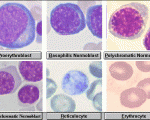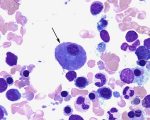
Segmented neutrophilic granulocyte during degradation
Segmented neutrophilic granulocyte during degradation, often seen as an artifact after prolonged sample storage (more than eight hours).

DIC (Disseminated intravascular coagulation)
This is an unusual situation in which there’s a generalised consumption of plasma clotting elements and platelets leading to fibrin deposition throughout the microcirculation. ...

Bleeding Time Overview
Bleeding Time is a screening test for disorder of platelets function, both congenital and acquired: useful in the diagnosis of Von Willebrand’s disease. Thrombocytopenia or aspirin ...

Proerythroblast
The proerythroblast varies from 12 to 20 μm in diameter and has a large nucleus that occupies most of the cell. The chromatin strands are fine, giving an even reticular appearance. ...

Normoblastic Erythropoiesis
Erythropoiesis is divided into a number of stages. The earliest recognisable red cell precursor in the bone marrow is known as the proerythroblast (Pronormoblast); this gives rise ...

Flame Cell
Flame cells are plasma cells with a distinctive pinkish hue in the outer rim of the cytoplasm. This appearance is thought to be the result of precipitated immunoglobulin. These cells ...

EDTA-Induced Pseudothrombocytopenia seen on blood smear
Pseudothrombocytopenia or spurious thrombocytopenia is an in-vitro sampling problem which may mislead the diagnosis towards the more critical condition of thrombocytopenia. The phenomenon ...

Blasts with eye catching distinct nucleoli
The prominent features in the arrowed cell of Image are the eye catching distinct nucleoli. The nucleoli, smooth chromatin, high nucleus to cytoplasm ratio and the appearance of accompanying ...

Prolymphocytic Leukemia (PLL)
This is a rare chronic lymphoproliferative disorder seen in elderly in which patients have high total leukocyte count along with massive splenomegaly. The prolymphocytes are morphologically ...



